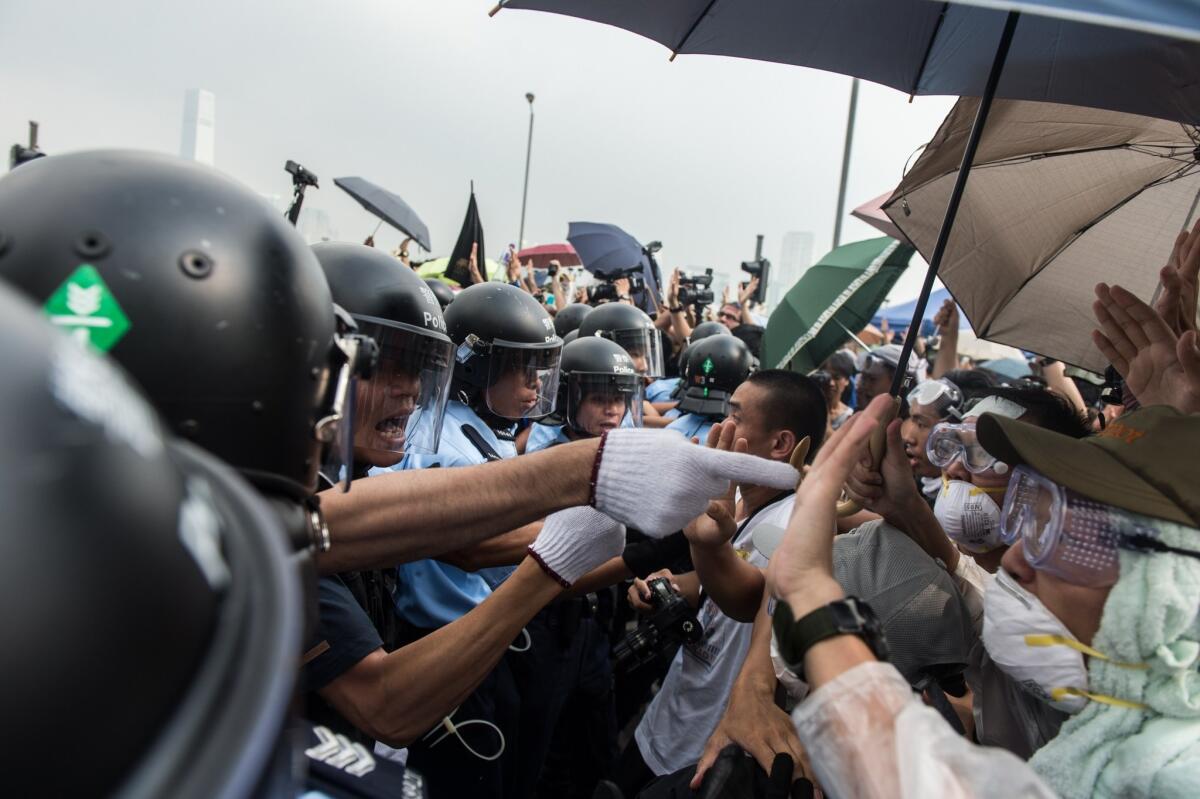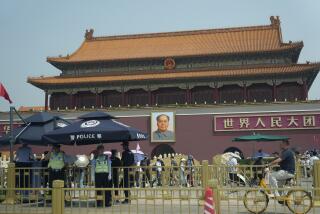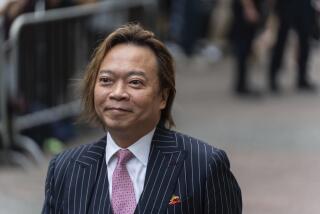Clashes erupt in Hong Kong between supporters, opponents of protests

- Share via
Reporting from Hong Kong — Screaming until they were red in the face, arguing until they burst into tears, supporters and opponents of Hong Kong’s democracy protests faced off Friday afternoon in the dense commercial district of Mong Kok.
“Get out!” yelled dozens of men, pumping their fists and urging police to clear the intersection of Nathan and Argyle roads, a busy crossroads with banks on each corner and shuttered jewelry shops and restaurants nearby.
Police struggled to keep the situation from erupting into a riot as periodic punches were thrown, water bottles were lobbed and curses hurled. As the afternoon wore on, the crowd swelled to perhaps 10,000.
“This is kind of the last stand,” said Adrian O’Sullivan, who moved to Hong Kong from Manchester, England, three years ago and has been joining in the democracy demonstrations all week. “This was the first spot on this side [of Victoria Harbor] where spontaneous protests broke out after people couldn’t get to Hong Kong Island to join the demonstrations there. We have to hold this.”
Mark Ledford, a tourist from Orange County, spent the afternoon taking in the scene at the intersection. “I don’t have politics when I’m on vacation, I like to say,” said Ledford, who runs a kids gym business in Rancho Santa Margarita and experienced tear gas earlier in the week when police clashed with protesters. “But I support what the students are doing out here.”
Ledford said that as a business owner, he understood that some proprietors may be upset about how the ongoing demonstrations have curtailed cash flow. But ultimately, he said, the foundations of enterprise depend on the kind of government protesters are seeking.
At 5:30 p.m. local time, a red canopy tent at the Nathan and Argyle intersection was torn down and police, linked arm in arm, opened up a lane of traffic. Several buses, which had been halted in the intersection for days and covered with pro-democracy fliers, were driven out of the area.
A small group of democracy demonstrators seemed to be encircled in the main intersection by opponents and police.
In a bizarre turn of events, police were essentially protecting the democracy protesters in the intersection who were besieged on all sides by opponents.
Around 6 p.m., organizers started suggesting to supporters that they abandon the Mong Kok encampment, but a die-hard group refused to leave.
Franco Mella, a priest from Italy, shook his head as a man with a megaphone exhorted the crowd outside the intersection to move in and clear away the democracy demonstrators. “A lot of people here have strong memories of Tiananmen,” he said, referring to the 1989 student protests crushed in Beijing. “This is strong in people’s minds now.”
Mella, who speaks fluent Cantonese, said some of the opponents in the crowd were local shopkeepers, but that he had heard others were paid the equivalent of about $100 by Triad gangs to turn up and shout slogans.
As he spoke, a man with a bloodied face was hustled under the protesters’ tent for medical attention.
After nightfall, the three leading protest groups -- Hong Kong Federation of Students, Scholarism and Occupy Central With Love and Peace -- issued a statement saying the government must prevent organized attacks on protesters. The federation later said it was suspending for now plans to hold talks with top government aide Carrie Lam.
With demonstrations in their sixth day and a sense of exhaustion setting in among supporters, the protesters seemed to be facing a choice of giving up spots such as Mong Kok and Causeway Bay and consolidating in other locations, or staying and risking violence and a loss of public support.
The Hong Kong government closed its central office and asked civil servants to work from home or at alternative locations.
Intermittent rain sapped strength from the demonstrators’ numbers, and a sense of uncertainty lingered over the movement after an offer Thursday night by embattled Chief Executive Leung Chun-ying to hold talks with the student federation.
As of midday Friday, no date, time or venue for the talks had been announced. The students want the conversation to take place in a public forum with media present.
Some schools remained closed Friday, and many bus routes were still diverted. Protesters outside Leung’s office on occasion blocked Lung Wo Road, the sole major east-west artery remaining open on Hong Kong Island’s densely populated north shore.
A government spokesman condemned the protesters for blocking police in their attempts to deliver food and water to officers stationed in government buildings. A statement suggested that the protesters were being directed not by student leaders or the Occupy Central movement but by “radical social activists.”
Police said the blockade was “almost paralyzing” traffic and was affecting emergency services. “This conduct is irresponsible and illegal,” the force said in a statement, though officers apparently made no arrests.
While some shop owners have started to complain that business was suffering because of the protests, Hong Kong’s stock market reopened Friday after a two-day holiday and was flat as of early afternoon.
In Beijing, the Communist Party mouthpiece People’s Daily continued to condemn the protests in Hong Kong. The newspaper said the demonstrations are aimed at challenging “China’s supreme power organ” and are doomed to fail.
“There is no room to make concessions on issues of important principles,” the commentary said.
Hong Kong, a former British territory, returned to Chinese rule under a formula known as “one country, two systems.” Those in the territory of 7 million were promised greater civil liberties than their mainland counterparts.
Chinese leaders have said Hong Kong voters can for the first time cast ballots in 2017 for the chief executive, now chosen by a Beijing-friendly committee of 1,200 people. However, authorities want to limit voters’ choice to two or three candidates who pass muster with Beijing, which protesters say amounts to “fake democracy.”
Follow @JulieMakLAT for news from China
More to Read
Sign up for Essential California
The most important California stories and recommendations in your inbox every morning.
You may occasionally receive promotional content from the Los Angeles Times.











